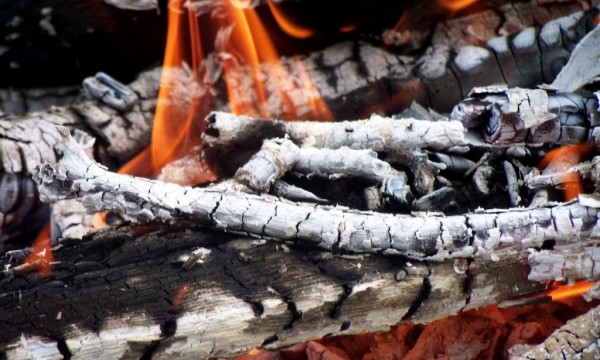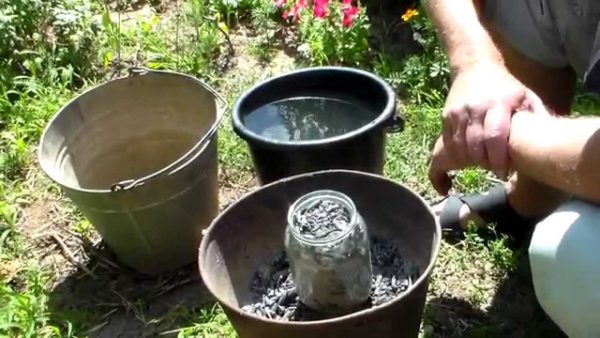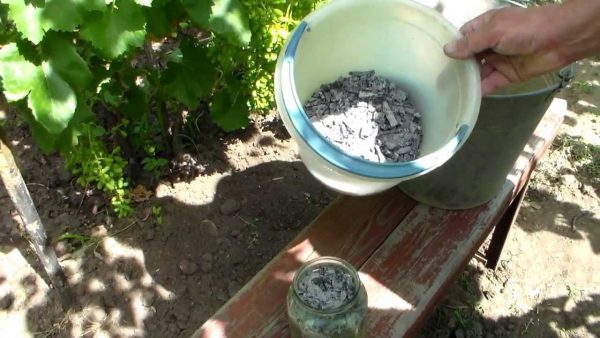Effective and simple fertilization wood ash: application in the garden and in the garden
Content
Where to get and how to store ash
The ash value is determined by the raw material. The most useful is the one that is obtained after burning seaweed. This is what scientists say. Practical gardeners believe that only what has grown in a given area will be of the greatest benefit to the soil. They advise giving preference to the combustion product of deciduous trees, fallen leaves, young growth. For some reason, it is believed that coniferous ash contains less useful substances, although the amount of calcium, potassium, phosphorus in it is approximately the same as in ash from birch.
Be that as it may, branches of trees and fruit shrubs after pruning, foliage, grass, tops of vegetables, grapes, all climbing plants can be burned, and the final product can be used in your personal plot or summer cottage. The main thing is not to throw plastic, polyethylene or anything like that into the fire. Experienced gardeners warn that glossy (coated) paper contains toxins that, when burned, are released into the air and remain in the ashes - it is better not to risk it. If you suddenly have the opportunity to purchase wood ash, do not neglect it - this substance can be perfectly stored in a place inaccessible to moisture for an unlimited amount of time. Do not rush to use it all at once, it is very useful only if the application is correct.
Coal ash is used much less often, because the trace elements contained in it are not so easily absorbed by plant roots, their content leaves much to be desired. It is successfully used for draining and loosening heavy clay soils, draining marshy lowlands. Coal ash can only be used in a vegetable garden or in a flower pot as drainage.
Video "Instructions on how to apply ash to soil"
Video instruction on the use of ash in the garden and garden for soil and plants.
Application as fertilizer
Wood ash does not contain chlorine - this expands the possibilities of its use, especially for chlorine-sensitive crops (potatoes, raspberries, currants, strawberries). But it alkalizes the soil, so its use is advisable only on acidic or neutral soils. You cannot fertilize blueberries, blueberries, rhododendrons with it, which love to grow on acidic soils. Before the autumn and spring digging of a site with heavy soil, 100-200 g of ash is applied per 1 square meter, for light sandy loam soils, only spring application is left. This makes the soil in the garden looser, more breathable, and helps the plants take root after transplantation.
When preparing beds for vegetables, it is advised to add 1 glass of ash per 1 square meter or put 1 to 3 tablespoons in each hole during planting of seedlings of cucumbers, zucchini, squash, peppers, eggplants, tomatoes. It is useful for potatoes, cabbage, all flowering perennials.Currant loves wood ash: you can pour up to 3 glasses under each bush, and then immediately embed them in the ground. It brings great benefits to fruit trees, especially its use for plums and cherries. Once every few years, a small ditch (up to 15 cm deep) is dug around the trunk around the crown perimeter, 1.5–2 kg of ash is poured there (for an adult tree), or a solution is poured, then immediately covered with soil.
The widespread use of ash in the garden is explained by the benefits that it brings to vegetables. For example, potassium and calcium are necessary for cucumbers to help form whips, ovaries, and retain moisture in cells. You can pour dry ash on the site before watering, you can make an infusion or solution, water the plants with it. The same applies to tomatoes, 5-7 days after feeding, their growth is already noticeably more active. They are usually fed several times a season, except for the introduction of dry matter during the preparation of the garden.
Ash is used not only in the country, indoor flowers also respond gratefully to such fertilization. Cyclamen, geranium, fuchsia, begonia bloom better in summer, do not lose the color of leaves in winter, if you feed them with a mixture of wood ash with sleeping tea.
Ash against diseases and pests
This substance is capable of not only fertilizing, but also treating and protecting against all kinds of pests, which is very important in the garden. You can protect your plants from slugs, Colorado potato beetle larvae, and cruciferous flea beetles by spraying or sprinkling. Dry ash is deadly for snails and slugs - it sucks up water, so they will not climb onto the area sprinkled with it. It is advisable to pour the sifted ash onto moistened plants so that it stays there longer. Or spray with a solution when direct sunlight will not burn the greens.
An infusion of ash, mixed with a decoction of herbs, will help protect plants from black leg, powdery mildew, leaf spot. He will scare away wireworms, aphids, flea beetles, a scoop. A good remedy for aphids is ash infusion combined with a soapy solution. They should process green spaces early in the morning or in the evening.
Adding ash to the soil saves the onion from root rot. A mixture of wood ash and tobacco dust will scare off onion flies. Ashes in the ground will save the roots from the beetle larvae. Currants and gooseberries are sprayed with ash infusion so that snails, slugs, powdery mildew, moth caterpillars, and sawfly larvae do not harm. Ants, wireworms, nematodes are also afraid of him.A solution of ash and laundry soap is used in the garden against such pests as moth caterpillars and hawthorns, kidney moths, all kinds of aphids, apple moth. Trees are sprayed with this solution at dawn or in the evening several times.
How to prepare ash solution
Decoctions and infusions of ash can be surprisingly useful not only for plant nutrition, but also for their protection and treatment. Prepare funds in several ways. If you pour 300 g of sifted ash with boiling water and boil for at least 25 minutes, and then strain and dilute with 10 liters of water, then we get a universal broth. They can water vegetables and flowers for feeding. And you can spray the aboveground part to protect against pests.
In the latter case, to enhance the effect, you can add 50 g of laundry soap, this will help small particles of the active substance stay longer on the leaves and stems of plants. If you don't want to pour ash into each hole when planting, measuring the required amount for each plant, you can prepare a solution that will suit all crops in the garden. To do this, pour 1 glass of ash with 10 liters of water and stir well. Such a solution is poured into a hole near the plant and immediately sealed with soil.
Some gardeners soak seeds in an ash solution for better germination and protection from pests. For him, 2 tablespoons of the substance, poured with 1 liter of water, are enough. To fertilize vegetables, make a solution of 150 g of ash and 1 bucket of water.Stir it, pour it into the prepared grooves between the rows of vegetables and immediately cover it with earth. This is how cabbage, cucumbers and tomatoes are fed. Wood ash can be poured onto the ground, sprinkled with plants, watered with solution - it is useful in any form in the garden and in the garden. You just need to remember about its ability to deoxidize the soil.
Plant Expert Opinion Video
An informative video in which a plant expert explains the pros and cons, and the use of ash in your vegetable garden and orchard.





